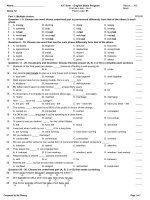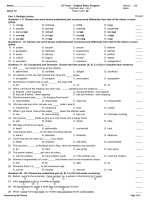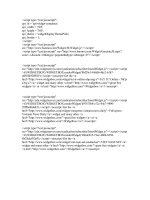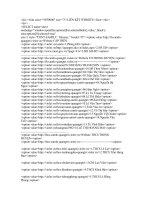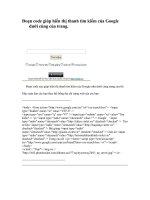lab08 code forensics
Bạn đang xem bản rút gọn của tài liệu. Xem và tải ngay bản đầy đủ của tài liệu tại đây (354.35 KB, 7 trang )
Lab: Code Forensics and Ransomware
The code objectives of this part of the lab are to:
•
•
•
•
Understand the lack of protection that .NET and Java have with code protection.
Investigate methods of obfuscation of code.
Create Microsoft .NET code in order to investigate a host.
Analyse a ransomware evidence bag.
Lab demo:
/>
Microsoft .NET Obfuscation
A.1
Microsoft .NET does not have inherent protection against the reverse engineering
of the code. To prove this, first create a C# program named simple.cs, with the
contents of:
namespace simple {
class simple {
private static void Main(string[] args) {
string s;
System.Console.Write("What is your name?");
s = System.Console.ReadLine();
System.Console.WriteLine("Hello " + s);
}
}
}
A.2
Compile the program, and program and make sure that that it works. From the
command prompt you can compile it with:
csc simple.cs
Note: To compile a .NET 2.0 program, you can access the compiler from:
c:\windows\Microsoft.NET\Framework\v2.0.50727\csc.exe
A.3
Next download the reverse engineering package from:
/>and prove that you can reverse the code using:
exemplar simple.exe > mycode.cs
A.4
Next run the obfuscator (from 9Rays) with:
ob.exe FTBSNM4ALPERC9# /src=simple.exe
The obfuscator is downloaded from:
1
/>A.5
Go into the /obfuscated folder, and copy the obfuscated EXE into the home
folder. Show that the EXE is now obfuscated.
What has changed in the obfuscated EXE?
Is it still possible to compile the reverse engineered code? Yes/No
Using Google, which packages can be used to obfuscate .NET assemblies?
Which options in the obfuscator changes the names of the variables to nonprinting characters?
Create the following C# file and compile it to an EXE:
using System;
namespace simple {
class simple {
public static int calc(int a, int b)
{
return(a+b);
}
private static void Main(string[] args) {
string s;
s="What is the capital of England";
int val1=5;
int val2=6;
System.Console.Write(s);
s = System.Console.ReadLine();
if (s=="London")
{
System.Console.WriteLine("Correct");
}
else
System.Console.WriteLine("Incorrect");
System.Console.WriteLine("Result is: "+Convert.ToString(calc(val1,val2)));
}
}
}
2
Now download ILSPY from:
/>Can you view your EXE in ILSPY?
Now obfuscated your EXE with the following options and observe the changes in ILSPY:
ob.exe NT /src=simple.exe
ob.exe 9 /src=simple.exe
ob.exe 8 /src=simple.exe
Java Reverse Engineering
A.6
Create a Java program (sample.java) with:
public class sample
{
public static void main(String[] args)
{
int i;
i=10;
System.out.println("This is an example of the ");
System.out.println("output from the standalone");
System.out.println("program");
System.out.println("The value of i is " + i);
}
}
A.7
Next produce the byte code with:
javac sample.java
If your system does not find the Java compiler you can normally run from a folder on your system, such
as:
C:\Program Files (x86)\Java\jdk1.7.0_71\bin\javac.exe
A.8
Finally download JAD, and try and decompile the byte code. Prove that you
can reverse the code. The download for JAD is at:
/>3
Using Google, which packages can be used to obfuscate Java class files?
Ransomware Analysis
The following page contains an evidence bag for the Cerber ransomware. Complete the tutorial:
/>
Additional Python Lab
We normally detect a file with its magic number, which is often the first few bytes at the start of
the file, or at the end. For example, a JPEG file begins with the hex sequence of ‘FF’ and ‘D8’. The
following is the Python code to determine a JPEG file:
f = open("1111.jpg", "rb")
try:
byte1 = hex(ord(f.read(1)))
byte2 = hex(ord(f.read(1)))
if (byte1=='0xff' and byte2=='0xd8'):
print 'JPEG'
finally:
f.close()
Table 1 outlines some magic number (refer to />Implement a Python program which detects file types for their magic numbers.
Table 1: Magic numbers
Description
Adobe Illustrator
Bitmap graphic
JPEG graphic file
JPEG 2000 graphic
file
GIF graphic file
TIF graphic file
PNG graphic file
Photoshop Graphics
Windows Meta File
MIDI file
Icon file
MP3 file with ID3
identity tag
AVI video file
Flash Shockwave
Flash Video
Mpeg 4 video file
MOV video file
Extension
.ai
.bmp
.jpg
Magic Number
25 50 44 46 [%PDF]
42 4D [BM]
FFD8
.jp2
0000000C6A5020200D0A [....jP..]
.gif
.tif
.png
.psd
.wmf
.mid
.ico
47 49 46 38 [GIF89]
49 49 [II]
89 50 4E 47 .PNG
38 42 50 53 [8BPS]
D7 CD C6 9A
4D 54 68 64 [MThd]
00 00 01 00
.mp3
49 44 33 [ID3]
.avi
.swf
.flv
.mp4
.mov
52 49 46 46 [RIFF]
46 57 53 [FWS]
46 4C 56 [FLV]
00 00 00 18 66 74 79 70 6D 70 34 32 [....ftypmp42]
6D 6F 6F 76 [....moov]
4
.wmv
Windows Video file
Windows Audio file .wma
.zip
PKZip
.gz
GZip
.tar
Tar file
.msi
Microsoft Installer
.obj
Object Code File
.dll
Dynamic Library
.cab
CAB Installer file
.exe
Executable file
.rar
RAR file
.sys
SYS file
.hlp
Help file
.vmdk
VMWare Disk file
Outlook Post Office
.pst
file
PDF Document
.doc
Word Document
.rtf
RTF Document
.xls
Excel Document
PowerPoint Document .ppt
.vsd
Visio Document
DOCX (Office 2010) .docx
XLSX (Office 2010) .xlsx
PPTX (Office 2010) .pptx
Microsoft Database .mdb
.ps
Postcript File
.jar
Jar File
30 26 B2 75 8E 66 CF
30 26 B2 75 8E 66 CF
50 4B 03 04 [PK]
1F 8B 08
75 73 74 61 72
D0 CF 11 E0 A1 B1 1A E1
4C 01
4D 5A [MZ]
4D 53 43 46 [MSCF]
4D 5A [MZ]
52 61 72 21 1A 07 00 [Rar!...]
4D 5A [MZ]
3F 5F 03 00 [?_..]
4B 44 4D 56 [KDMV]
21 42 44 4E 42 [!BDNB]
25 50 44 46 [%PDF]
D0 CF 11 E0 A1 B1 1A E1
7B 5C 72 74 66 31 [{ tf1]
D0 CF 11 E0 A1 B1 1A E1
D0 CF 11 E0 A1 B1 1A E1
D0 CF 11 E0 A1 B1 1A E1
50 4B 03 04 [PK]
50 4B 03 04 [PK]
50 4B 03 04 [PK]
53 74 61 6E 64 61 72 64 20 4A 65 74
25 21 [%!]
50 4B 03 04 14 00 08 00 08 00
There are more than 30 files contained in this evidence bag:
/>Now, using your Python program, see if you can match the magic number, and then change the file
extension, and see if you can view them.
File
file01
Type
What it contains …
file02
file03
file04
file05
file06
5
file07
file08
file09
file10
file11
file12
file13
file14
file15
file16
file17
file18
file19
file20
file21
file22
file23
file24
file25
file26
file27
file28
file29
file30
file32
file33
6
file34
file35
file36
file37
file38
file39
file40
7

